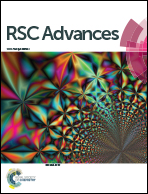Synthesis and in vitro cytotoxicity evaluation of ruthenium polypyridyl-sensitized paramagnetic titania nanoparticles for photodynamic therapy†
Abstract
Magnetite/silica/titania core–shell–shell nanoparticles were synthesized by sol–gel methods and characterized by various methods. The hydrodynamic radius of the final nanoparticle sample was measured by dynamic light scattering and found to be 99 nm. Following hydrothermal treatment of the final nanocomposites, a ruthenium polypyridyl dye was anchored to the surface. The total potential reactive oxygen species (ROS) generation and singlet oxygen (1O2) production in solution by the hybrid NPs (naked NPs + ruthenium dye) were evaluated by fluorescence and UV-Vis spectroscopy. Under 532 nm light illumination, more than a five-fold increase in ROS production was observed with the hybrid NPs in comparison to the bare NPs or the ruthenium dye alone. Similar results were obtained under white light illumination as well. Moreover, singlet oxygen generation produced by the hybrid NPs was found to be negligible. The photodynamic effect of the excited NPs on the viability of lung cancer cells (A549) was evaluated in vitro. ROS production in A549 NP-loaded cells was measured and a live/dead cell assay was conducted. There was a significant, light excitation-dependent increase in ROS production and induction of cell death in light excited A549 NP-loaded cells as compared to control cells and NP loaded cells without excitation. These findings demonstrate that the hybrid NPs can potentially act as type I photodynamic therapy (PDT) agents generating free radicals, unlike the currently employed ones in medicine which follow a type II mechanism predominantly (generating singlet oxygen). This type of photosensitizers can prove advantageous in eradicating PDT-resilient hypoxic tumors, avoiding type II photosensitizers-induced hypoxia in non-hypoxic tumor cells.


 Please wait while we load your content...
Please wait while we load your content...